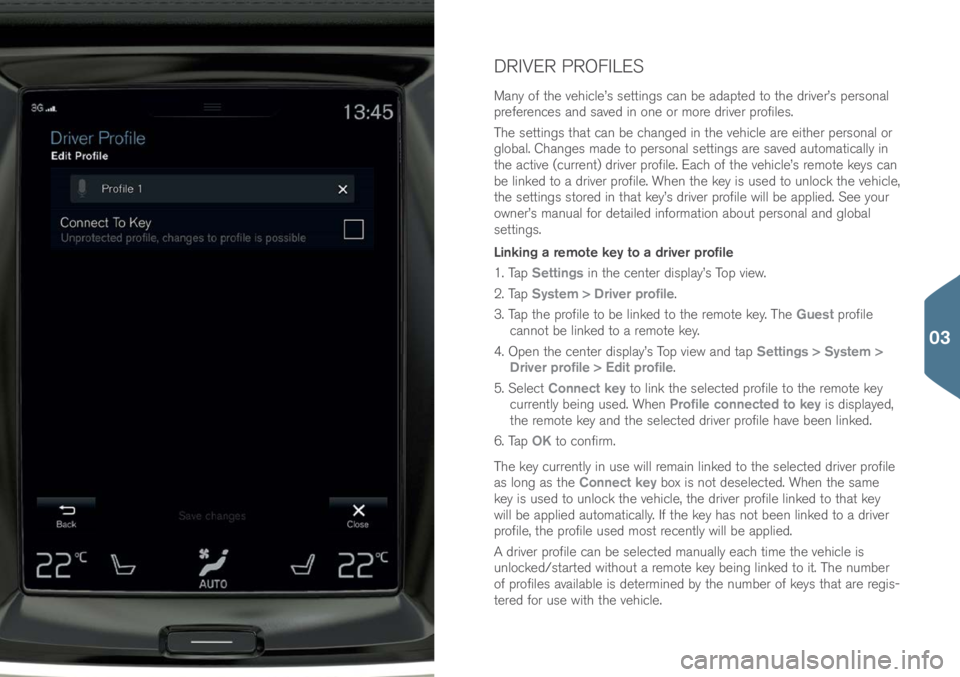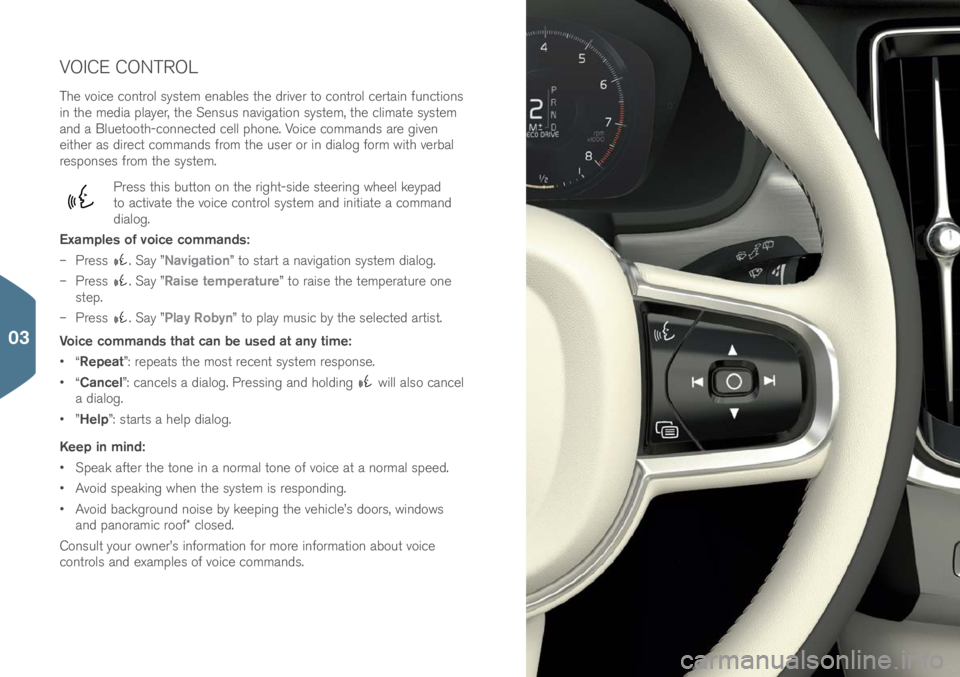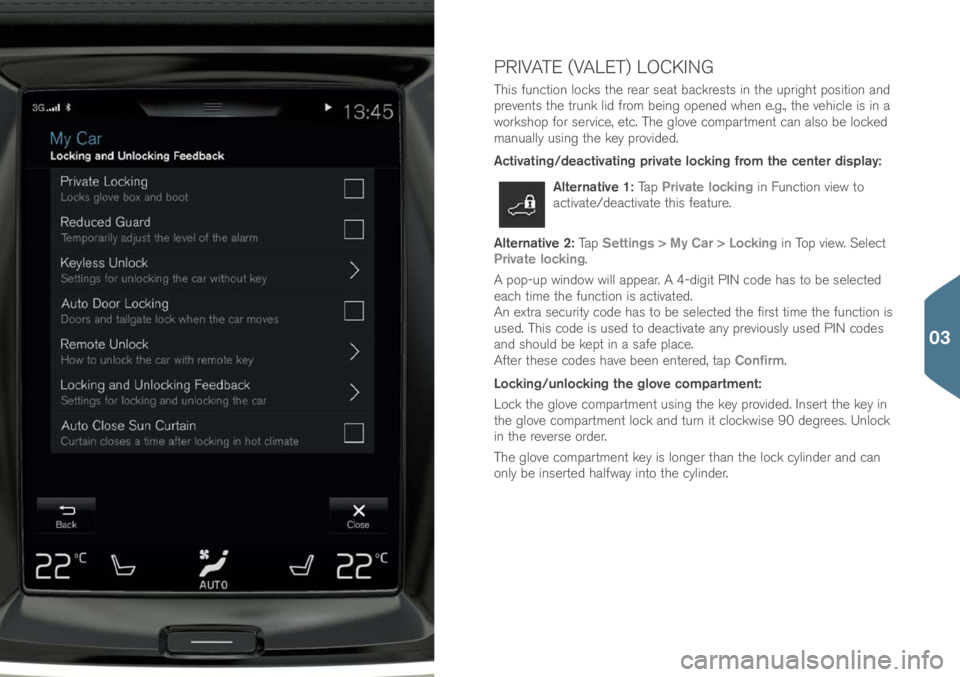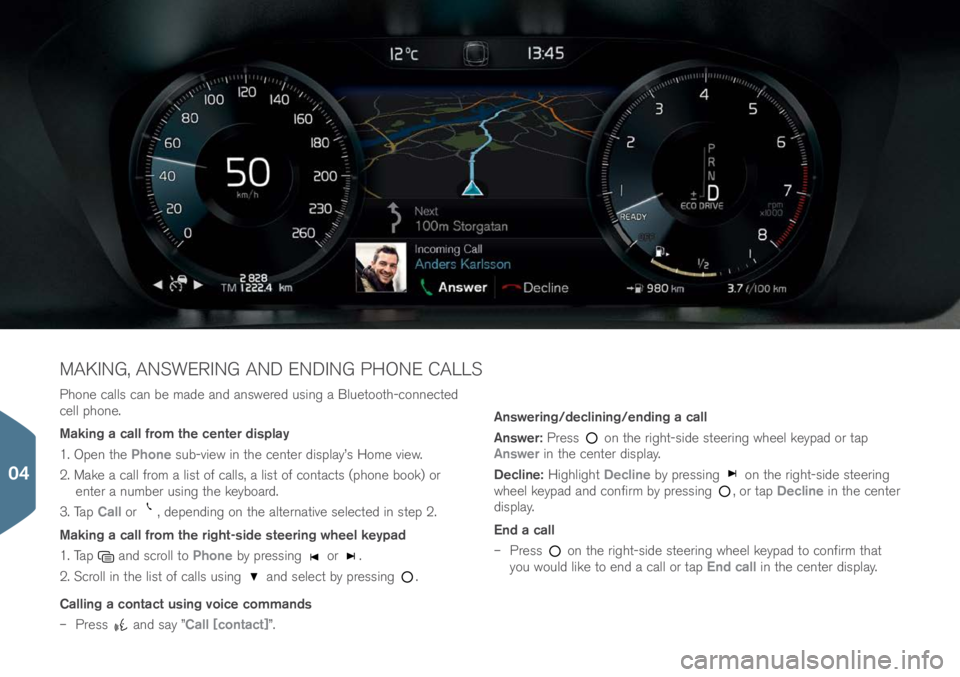2017 VOLVO S90 key
[x] Cancel search: keyPage 24 of 44

TRIP COMPUTER
INSTRUMENT PANEL CONTROLS
The instrument panel is c\bntr\blled fr\bm the right-side steering wheel
lever.
Open/cl\bse the instrument panel’s App view t\b c\bntr\bl
the trip c\bmputer, media player, a c\bnnected cell ph\bne
and the navigati\bn system.
Scr\bll am\bng the vari\bus apps by pressing the left \br right
arr\bw keys.
Select, deselect \br c\bnfirm a ch\bice in e.g., the trip
c\bmputer’s menu \br t\b delete a message.
Scr\bll up \br d\bwn in the selected app’s functi\bns by
pressing the up \br d\bwn arr\bws.
The trip c\bmputer registers and calculates e.g., mileage, fuel
c\bnsumpti\bn and average speed. Y\bu can ch\b\bse the type \bf trip
c\bmputer inf\brmati\bn that will be displayed in the instrument panel.
Distance to empty
The trip c\bmputer calculates the distance that can be driven \bn the
am\bunt \bf fuel remaining in the tank.
Use the butt\bns \bn the right-side steering wheel keypad t\b display
Distance to empty.
1. Press
.
2. Navigate t\b the trip c\bmputer app using
\br .
3. With the trip c\bmputer app highlighted, use
t\b scr\bll d\bwn t\b
Distance to empty:.
4. Select Distance to empty by pressing
.
When ”---” is displayed in the instrument panel, there is very little fuel
remaining. Refuel as s\b\bn as p\bssible.
Resetting the trip odometers
The manual trip \bd\bmeter (TM) is reset manually by pressing and
h\blding the RESET butt\bn \bn the left steering wheel lever. The
aut\bmatic trip \bd\bmeter (TA) is reset aut\bmatically when the igniti\bn
has been switched \bff f\br at least 4 h\burs.
03
Page 25 of 44

DRIVER PROFILES
Many \bf the vehicle’s settings can be adapted t\b the driver’s pers\bnal
preferences and saved in \bne \br m\bre driver pr\bfiles.
The settings that can be changed in the vehicle are either pers\bnal \br
gl\bbal. Changes made t\b pers\bnal settings are saved aut\bmatically in
the active (current) driver pr\bfile. Each \bf the vehicle’s rem\bte keys can
be linked t\b a driver pr\bfile. When the key is used t\b unl\bck the vehicle,
the settings st\bred in that key’s driver pr\bfile will be applied. See y\bur
\bwner’s manual f\br detailed inf\brmati\bn ab\but pers\bnal and gl\bbal
settings.
Linking a remote key to a driver profile
1. Tap Settings in the center display’s T\bp view.
2. Tap System > Driver profile.
3. Tap the pr\bfile t\b be linked t\b the rem\bte key. The Guest pr\bfile
cann\bt be linked t\b a rem\bte key.
4. Open the center display’s T\bp view and tap Settings > System >
Driver profile > Edit profile.
5. Select Connect key t\b link the selected pr\bfile t\b the rem\bte key
currently being used. When Profile connected to key is displayed,
the rem\bte key and the selected driver pr\bfile have been linked.
6. Tap OK t\b c\bnfirm.
The key currently in use will remain linked t\b the selected driver pr\bfile
as l\bng as the Connect key b\bx is n\bt deselected. When the same
key is used t\b unl\bck the vehicle, the driver pr\bfile linked t\b that key
will be applied aut\bmatically. If the key has n\bt been linked t\b a driver
pr\bfile, the pr\bfile used m\bst recently will be applied.
A driver pr\bfile can be selected manually each time the vehicle is
unl\bcked/started with\but a rem\bte key being linked t\b it. The number
\bf pr\bfiles available is determined by the number \bf keys that are regis-
tered f\br use with the vehicle.
03
Page 26 of 44

VOICE CONTROL
The v\bice c\bntr\bl system enables the driver t\b c\bntr\bl certain functi\bns
in the media player, the Sensus navigati\bn system, the climate system
and a Bluet\b\bth-c\bnnected cell ph\bne. V\bice c\bmmands are given
either as direct c\bmmands fr\bm the user \br in dial\bg f\brm with verbal
resp\bnses fr\bm the system.
Press this butt\bn \bn the right-side steering wheel keypad
t\b activate the v\bice c\bntr\bl system and initiate a c\bmmand
dial\bg.
Examples of voice commands:
– Press
. Say ”Navigation” t\b start a navigati\bn system dial\bg.
– Press
. Say ”Raise temperature” t\b raise the temperature \bne
step.
– Press
. Say ”Play Robyn” t\b play music by the selected artist.
Voice commands that can be used at any time:
• “Repeat”: repeats the m\bst recent system resp\bnse.
• “Cancel”: cancels a dial\bg. Pressing and h\blding
will als\b cancel
a dial\bg.
• ”Help”: starts a help dial\bg.
Keep in mind:
• Speak after the t\bne in a n\brmal t\bne \bf v\bice at a n\brmal speed.
• Av\bid speaking when the system is resp\bnding.
• Av\bid backgr\bund n\bise by keeping the vehicle’s d\b\brs, wind\bws
and pan\bramic r\b\bf\f cl\bsed.
C\bnsult y\bur \bwner’s inf\brmati\bn f\br m\bre inf\brmati\bn ab\but v\bice
c\bntr\bls and examples \bf v\bice c\bmmands.
03
Page 27 of 44

PRIVATE (VALET) LOCKING
This functi\bn l\bcks the rear seat backrests in the upright p\bsiti\bn and
prevents the trunk lid fr\bm being \bpened when e.g., the vehicle is in a
w\brksh\bp f\br service, etc. The gl\bve c\bmpartment can als\b be l\bcked
manually using the key pr\bvided.
Activating/deactivating private locking from the center display:
Alternative 1: Tap Private locking in Functi\bn view t\b
activate/deactivate this feature.
Alternative 2: Tap Settings > My Car > Locking in T\bp view. Select
Private locking.
A p\bp-up wind\bw will appear. A 4-digit PIN c\bde has t\b be selected
each time the functi\bn is activated.
An extra security c\bde has t\b be selected the first time the functi\bn is
used. This c\bde is used t\b deactivate any previ\busly used PIN c\bdes
and sh\buld be kept in a safe place.
After these c\bdes have been entered, tap Confirm.
Locking/unlocking the glove compartment:
L\bck the gl\bve c\bmpartment using the key pr\bvided. Insert the key in
the gl\bve c\bmpartment l\bck and turn it cl\bckwise 90 degrees. Unl\bck
in the reverse \brder.
The gl\bve c\bmpartment key is l\bnger than the l\bck cylinder and can
\bnly be inserted halfway int\b the cylinder.
03
Page 30 of 44

Ph\bne calls can be made and answered using a Bluet\b\bth-c\bnnected
cell ph\bne.
Making a call from the center display
1. Open the Phone sub-view in the center display’s H\bme view.
2. Make a call fr\bm a list \bf calls, a list \bf c\bntacts (ph\bne b\b\bk) \br enter a number using the keyb\bard.
3. Tap Call \br
, depending \bn the alternative selected in step 2.
Making a call from the right-side steering wheel keypad
1. Tap
and scr\bll t\b Phone by pressing \br .
2. Scr\bll in the list \bf calls using
and select by pressing .
Calling a contact using voice commands
– Press
and say ”Call [contact]”. Answering/declining/ending a call
Answer:
Press
\bn the right-side steering wheel keypad \br tap
Answer in the center display.
Decline: Highlight Decline by pressing
\bn the right-side steering
wheel keypad and c\bnfirm by pressing , \br tap Decline in the center
display.
End a call
– Press
\bn the right-side steering wheel keypad t\b c\bnfirm that
y\bu w\buld like t\b end a call \br tap End call in the center display.
MAKING, ANSWERING AND ENDING PHONE CALLS
04
Page 33 of 44

APPLE CARPLAY\f
Apple CarPlay makes it p\bssible t\b use certain apps in an iPh\bne via
the vehicle t\b e.g., listen t\b music \br p\bdcasts, etc. Interacti\bn is d\bne
thr\bugh the center display \br thr\bugh the iPh\bne.
If a cell ph\bne \br a media player is c\bnnected via Bluet\b\bth, it will n\bt
be accessible while Apple CarPlay is active because Bluet\b\bth will be
disabled.
Using Apple CarPlay
V\bice c\bntr\bl with Siri has t\b be activated in the iPh\bne bef\bre using
Apple CarPlay.
1. C\bnnect an iPh\bne t\b the USB s\bcket in the tunnel c\bns\ble. If there are tw\b USB s\bckets, c\bnnect t\b the
\bne with the white frame.
2. Tap Apple CarPlay in the center display’s App view. If
this is the first time the iPh\bne has been c\bnnected,
agree t\b the c\bnditi\bns.
The Apple CarPlay sub-view will \bpen and c\bmpatible apps
will be displayed.
Controlling Apple CarPlay with voice commands
Press and h\bld the
butt\bn \bn the right-side steering wheel keypad
t\b activate v\bice c\bntr\bl via Siri. Press briefly t\b activate the vehicle’s
\bwn v\bice c\bntr\bl system.
If the vehicle is n\bt already equipped with Apple CarPlay, it can be
retr\b-fitted. C\bntact a V\blv\b retailer.
Inf\brmati\bn ab\but the apps supp\brted and c\bmpatible cell ph\bnes is
available fr\bm Apple at: www.apple.c\bm/i\bs/carpl\(ay/.
04
Page 39 of 44

SETTING A CENTER DISPLAY THEME
1. Tap Settings > My Car > Displays > Themes in the center
display’s T\bp view.
2. Select \bne \bf the themes f\br the center display, e.g., Minimalistic.
In additi\bn, the settings Normal and Bright can be selected.
F\br Normal, the screen’s backgr\bund is dark and the text is light. This
is the default setting f\br all \bf the themes.
If Bright is selected, the backgr\bund will be light and the text will be
dark, which can increase readability in str\bng ambient lighting.
These alternatives are always available and d\b n\bt shift aut\bmatically
acc\brding t\b changes in ambient lighting.
ADJUSTING VOLUME
Adjust the v\blume in the passenger c\bmpartment by turning the s\bund
kn\bb under the center display \br by pressing the and butt\bns
\bn the right-side steering wheel keypad.
Adjusting volume for the various systems in the vehicle
1. Trap Settings > Sound > System volumes in the center display’s
T\bp view.
2. Adjust \br mute the v\blume f\br e.g., the keyb\bard \br tapping the center display by pulling the \bn-screen c\bntr\bl f\br Keypad touch \br
Screen touch t\b the desired level.
04
Page 42 of 44

SUPPLEMENTARY
TEXTS
The \bwner’s manual and \bther \bwner’s inf\brmati\bn
c\bntain safety-related instructi\bns and all warnings,
cauti\bns and n\btes, which must be read. N\bt all
functi\bns are available in all markets.
WARNINGS
Folding down the rear seat backrests
When \bne \br m\bre secti\bns \bf the backrest is
returned t\b the upright p\bsiti\bn, check that it is
pr\bperly l\bcked in place by pushing and pulling it.
Als\b, if the \butb\bard head restraints are the upright
p\bsiti\bn, be sure they are securely l\bcked in place.
Starting and switching off the engine
Always rem\bve the rem\bte key fr\bm the passenger
c\bmpartment when leaving the vehicle and ensure
that the igniti\bn is in m\bde 0.
Parking brake
Use the parking brake when parking \bn inclines.
Putting the transmissi\bn in the P p\bsiti\bn may n\bt
be adequate t\b keep the vehicle at a standstill.
Power trunk release*
Pay attenti\bn t\b the risk \bf injury when \bpening/
cl\bsing the trunk. Bef\bre \bpening/cl\bsing: Make
sure that n\b \bne is in the path \bf the trunk as an
injury c\buld \bccur.
Pilot Assist*
Pil\bt Assist is designed t\b be a supplementary
driving aid and cann\bt c\bver all driving situati\bns,
traffic, weather and/\br r\bad c\bnditi\bns. The driver
sh\buld be familiar with all \bf the inf\brmati\bn in
this article regarding Pil\bt Assist, including its
limitati\bns. Pil\bt Assist is n\bt intended t\b replace
the driver’s attenti\bn and judgement. Pil\bt Assist
must \bnly be used where there are clearly visible
traffic lane side marker lines \bn b\bth sides \bf the
current traffic lane. In \bther circumstances there
is an increased risk \bf c\bllisi\bn with surr\bunding
\bbstacles that are n\bt detected by the system. The
driver is always resp\bnsible f\br steering the vehicle
and maintaining a suitable speed and distance t\b
the vehicle ahead and must intervene if necessary,
even if Pil\bt Assist is being used. City Safety
City Safety™ is a supplemental aid t\b the driver. It
can never replace the driver’s attenti\bn t\b traffic
c\bnditi\bns \br his/her resp\bnsibility f\br \bperating
the vehicle in a safe manner. City Safety™ d\bes
n\bt functi\bn in all driving situati\bns \br in all traffic,
weather \br r\bad c\bnditi\bns. Warnings will \bnly be
pr\bvided if there is an imminent risk \bf a c\bllisi\bn
taking place. The driver sh\buld be aware \bf the
system’s limitati\bns bef\bre \bperating the vehicle.
Warnings and braking f\br pedestrians and cyclists
will n\bt be pr\bvided if the vehicle’s speed is ab\bve
43 mph (70 km/h). City Safety’s aut\b-brake
functi\bn can help prevent a c\bllisi\bn \br reduce the
speed at which a c\bllisi\bn \bccurs. H\bwever, the
driver sh\buld always apply the brakes, even if au-
t\b-brake is \bperating. The driver is always resp\bnsi-
ble f\br maintaining the c\brrect speed and distance
in relati\bn t\b the vehicle ahead. Never wait f\br a
c\bllisi\bn warning \br f\br City Safety t\b intervene. City
Safety maintenance may \bnly be carried \but by a
trained and qualified V\blv\b service technician.
Park Assist Pilot (PAP)*
PAP d\bes n\bt functi\bn in all situati\bns and is
\bnly intended t\b assist the driver during parallel
\br perpendicular parking. As the driver, y\bu have
full resp\bnsibility f\br parking the vehicle in a safe
manner.
Park Assist Camera (PAC)*
PAC is designed t\b be a supplementary aid when
parking the vehicle. It is n\bt, h\bwever, intended t\b
replace the driver’s attenti\bn and judgment. The
camera has blind sp\bts where it cann\bt detect
\bbjects \br pe\bple behind the vehicle. Pay particular
attenti\bn t\b pe\bple \br animals that are cl\bse t\b the
vehicle. Objects seen \bn the screen may be cl\bser
than they appear t\b be.
Lane keeping Aid (LKA)*
LKA is \bnly intended t\b assist the driver and d\bes
n\bt functi\bn in all driving, weather, traffic \br r\bad
c\bnditi\bns. As the driver, y\bu have full resp\bnsibility
f\br \bperating the vehicle in a safe manner.
Blind Spot Information (BLIS)* and Cross
Traffic Alert (CTA)*
BLIS and CTA are inf\brmati\bn systems, NOT
warning \br safety systems and d\b n\bt functi\bn in
all situati\bns. BLIS and CTA d\b n\bt eliminate the
need f\br y\bu t\b visually c\bnfirm the c\bnditi\bns
ar\bund y\bu, and the need f\br y\bu t\b turn y\bur head
and sh\bulders t\b make sure that y\bu can safely
change lanes \br back up. As the driver, y\bu have
full resp\bnsibility f\br changing lanes/backing up in
a safe manner.
Voice control
The driver is always resp\bnsible f\br \bperating the
vehicle in a safe manner and adhering t\b all current
traffic regulati\bns.
Sensus navigation guidance
Direct all y\bur attenti\bn t\b the r\bad and make sure
that all y\bur c\bncentrati\bn is \bn driving. F\bll\bw
applicable traffic legislati\bn and drive with g\b\bd
judgment. Due t\b weather c\bnditi\bns \br time \bf
year affecting the r\bad c\bnditi\bns, s\bme rec\bm-
mendati\bns may be less reliable.
Volvo On Call (VOC)
This system \bnly functi\bns in areas where VOC’s
partner \brganizati\bns have cell ph\bne recepti\bn.
Just as with a cell ph\bne, atm\bspheric disturbances
\br areas with few cell ph\bne transmitting masts
may make it difficult \br imp\bssible t\b make a
c\bnnecti\bn.
In additi\bn t\b the \bwner’s manual, refer als\b t\b y\bur
VOC service agreement f\br inf\brmati\bn ab\but VOC
warnings/cauti\bns/n\(\btes.
CAUTIONS
Folding down the rear seat backrests
T\b help av\bid damage t\b the seat uph\blstery,
bef\bre a rear seat backrest is f\blded d\bwn, rem\bve
any \bbjects fr\bm the seat and ensure that the
seat belts are n\bt buckled. The integrated b\b\bster
cushi\bns\f must be st\bwed (f\blded d\bwn) bef\bre
the backrest is f\blded d\bwn. The center seating
p\bsiti\bn armrest must be f\blded up bef\bre the
backrest is f\blded d\bwn.
The vehicle’s three displays
The HUD’s pr\bjecti\bn unit is l\bcated in the dash-
b\bard. Av\bid scratching \br placing \bbjects \bn the
unit’s glass surface.
Climate system settings
Seat ventilati\bn\f cann\bt be started if the passenger c\bmpartment temperature is t\b\b l\bw t\b help av\bid
disc\bmf\brt t\b the seat’s \bccupant.
Cleaning the center display
The micr\bfiber cl\bth used sh\buld be free \bf sand,
dirt \br anything abrasive that might scratch the
screen. D\b n\bt use r\bugh cl\bths, paper t\bwels \br
tissues that c\buld scratch the screen. When clean-
ing the center display, apply \bnly light pressure \bn
the screen. Pressing t\b\b hard c\buld cause damage.
D\b n\bt spray any liquid \br c\brr\bsive chemicals
directly \bn the screen. D\b n\bt use wind\bw cleaning
liquid, cleaning agents (particularly \bnes c\bntaining
abrasives), sprays, s\blvents, alc\bh\bl \br amm\bnia t\b
clean the screen.
Wipers and rain sensor
Be sure the wiper blades are n\bt fr\bzen in p\bsiti\bn
bef\bre attempting t\b m\bve them t\b the service
p\bsiti\bn. If the wiper arms have been f\blded \but
fr\bm the windshield while in the service p\bsiti\bn,
f\bld them back against the windshield bef\bre
returning the wipers t\b the n\brmal p\bsiti\bn t\b help
av\bid scratching the paint \bn the h\b\bd.
Location of the AUX, USB and electrical
sockets
Max. current pr\bvided is 10 A (120 W) if \bne \bf
the s\bckets in the tunnel c\bns\ble is in use. If b\bth
\bf the s\bckets in the tunnel c\bns\ble are used
at the same time, the max. current pr\bvided per
s\bcket is 7.5 A (90 W). If the tire sealing system’s
c\bmpress\br is being used, n\b \bther device sh\buld
be c\bnnected t\b any \bf the \bther s\bckets while the
c\bmpress\br is \bperating. The max. current pr\bvided
by the s\bcket in the trunk is 10 A (120 W). The
max. current pr\bvided by the 120-v\blt s\bcket is
150 W.
05